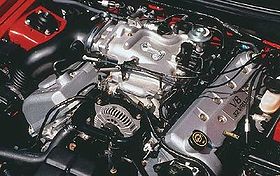| Ford Modular Engine | |
|---|---|
 A 1999 Ford Mustang SVT Cobra engine. | |
| Overview | |
| Manufacturer | Ford Motor Company |
| Also called |
|
| Production |
|
| Layout | |
| Configuration | 90° V8 and V10 |
| Displacement |
|
| Cylinder bore |
|
| Piston stroke |
|
| Valvetrain |
|
| Combustion | |
| Supercharger | Eaton M-112 roots-type in DOHC and 5.4 SOHC versions |
| Output | |
| Power output | 190–806 hp (142–601 kW) |
| Torque output | 260–679 lb⋅ft (353–921 N⋅m) |
| Chronology | |
| Predecessor | |
The Ford Modular engine is Ford Motor Company's overhead camshaft (OHC) V8 and V10 gasoline-powered small block engine family. Introduced in 1990, the engine family received its “modular” designation by Ford for its new approach to the setup of tooling and casting stations in the Windsor and Romeo engine manufacturing plants.
Such an approach allowed for significantly faster changeovers when switching from one engine platform to another among the Modular engine family. This also allowed for the existing engine plants, and their supporting offsite production facilities, to handle shorter production runs. Implementing shorter production runs without incurring large shutdown and retooling expenses helped to increase the versatility of those production stations that required tooling or machining setups specific to a certain vehicle platform.
The Modular engine family started with the 4.6 L in 1990 for the 1991 model year.[1] The Modular engines are used in various Ford, Lincoln, and Mercury vehicles. Modular engines used in Ford trucks were marketed under the Triton name from 1997–2010 while the InTech name was used for a time at Lincoln and Mercury for vehicles equipped with DOHC versions of the engines. The engines were first produced at the Ford Romeo Engine Plant, then additional capacity was added at the Windsor Engine Plant in Windsor, Ontario.
- ^ Smart, Jim (2005-10-05). "Ford Modular V-8 Engine". Mustang & Fords Magazine. US. Retrieved 2020-10-25.
